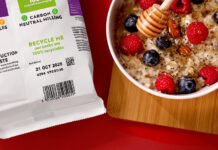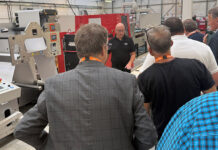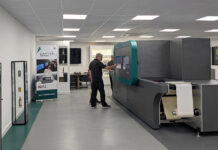
THERMAL ink jet (TIJ) is emerging as an affordable and practical coding option for food and other FMCG manufacturers, on the back of game-changing ink technology advancements and falling machine prices. Over a decade has passed since Thermal Ink Jet (TIJ) made its foray as an industrial coding technology, with the ultimate aim of usurping Continuous Ink Jet (CIJ) in many applications.
Early TIJ systems were essentially industrial versions of Hewlett Packard (HP) office printers that used standard water-based ink cartridges. With a price tag in the region of £6,000, they were expensive, and they also had considerable limitations, in that they couldn’t accommodate the solvent inks needed to print on non-porous surfaces. Even with these shortcomings, for pharmaceutical manufacturers, the cleanliness and high coding quality advantages of TIJ were important enough to justify investment in the technology. Indeed, some pharmaceutical companies changed their packaging to substrates that could support water-based inks just so they could run TIJ coders.
The food industry has not been as ready to adopt TIJ and CIJ has traditionally been the technology of choice, mainly due to ‘ink on substrate’ limitations. Unlike pharmaceutical manufacturers, food manufacturers had no requirement for printing high definition 2D codes, and the quality of CIJ codes was ‘good enough’ for the purpose of best before dates and batch codes.
Now, this long-held view is being challenged, as the barriers that have prevented wider adoption of TIJ – chiefly ink performance and equipment cost – have been addressed.
Recalculating costs
TIJ is now cheaper than CIJ, when considered on a cost of ownership basis. As TIJ has become more established, economies of scale have kicked in, and the units themselves are much cheaper to buy. Pricing is now comparable with CIJ units, although there are suppliers who will virtually give away a CIJ printer, knowing that it will be paid for indirectly in the form of ongoing consumable costs and service contracts. Regardless of the initial equipment cost – which is only the tip of the iceberg with coding solutions – TIJ will cost less than CIJ over its lifetime. As a rule of thumb, TIJ will work out at less than two thirds of the cost of CIJ when measured in terms of cost per 1000 prints.
The reason the cost of ownership is so much lower with TIJ is that it is a maintenance – and service – free technology. TIJ printers use a simple and robust cartridge system which combines both a printhead and ink supply system. Replacing the print cartridge effectively replaces the entire ink delivery systems, and this can be done within a few seconds, minimising downtime and eliminating the need for repairs and service contracts.
Cartridge operation makes TIJ a very clean method of coding, particularly in comparison to CIJ printers, which are renowned for the mess they make around them and require fluids to be added, introducing the risk of spillage and mess. TIJ is also on-demand, whereas CIJ is continuous, a distinction that has a bearing on cost of ownership. CIJ printers take time to start-up and shut-down. It is usual to see a purging station consisting of a head bracket and funnel – used to get a head running. Once up and running, CIJ printers are often left on all day. This means fluids are evaporating off into the atmosphere even when no coding is taking place. Furthermore, the ink drawn off during the purging process will need to be disposed of as hazardous waste.
By contrast, TIJ printers can be switched on and printing commenced straight away. A TIJ cartridge is ready to print as soon as it has been wiped and loaded into the printhead, and shut-down is simply a case of removing the cartridge, replacing it in its clip and switching-off. In this way, ink is only consumed when codes are being printed.

Thinking ink
Recent breakthroughs in ink technology have been the other game-changer for TIJ. Early TIJ printers were essentially descendants of HP desktop printers, which were designed for printing on paper substrates using water-based inks. Marking on any sort of glossy coating caused the ink to rub right off. In the FMCG world, however, users want to be able to print on glossy cartons, films and foils. In order to successfully print onto these non-porous substrates, TIJ printers need to use solvent-based inks. This is more challenging than it sounds, as filling a cartridge with MEK (the main solvent used in CIJ) would probably cause it to melt before your eyes. Any commercial TIJ also has to fire correctly from the nozzle, have a workable shelf life, be fast-drying and be light- and rub-resistant.
R&D has yielded gentler, lighter solvents which can be used in a TIJ cartridge without destroying it, enabling printing on non-porous, coated surfaces. Ink performance has also been improved – another criticism that used to be levelled at TIJ was that it could only print in grey – not black. Developments in this area have yielded inks with high optical darkness, so this is no longer an issue. Other technological advancements are making TIJ more attractive to a broader cross-section of users too. Whilst the early TIJ units took up large amounts of line space, TIJ equipment engineers have embraced developments in circuit board technology. By using efficient circuit boards that don’t occupy much space, they have been able to reduce the overall size of the printing unit.
There have also been considerable strides in decap time – that is, the length of time it takes for the ejectable liquid at the nozzle to clog, causing the printer to produce sub-standard codes when it is next started up. Additives can be used to increase decap time and inks have been formulated to offer decap times of up to 16 hours. This allows for intermittent industrial printing with immediate start-up.
Of course, TIJ is not without its limitations and is not perfect for every application. TIJ units cannot print upwards, which limits their usefulness in the beverage industry. However, for the vast majority of packaged product applications, TIJ offers huge advantages over CIJ in terms of convenience, cleanliness, clarity and cost. Developers of TIJ equipment and inks have risen to the challenge of improving ink performance and making machines more affordable.
Now it is down to manufacturers to put to one side any outdated perceptions of TIJ as expensive and base future purchasing decisions on cost of ownership calculations.












